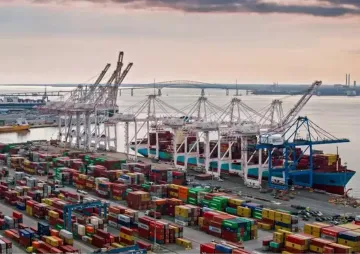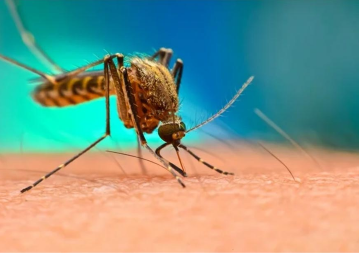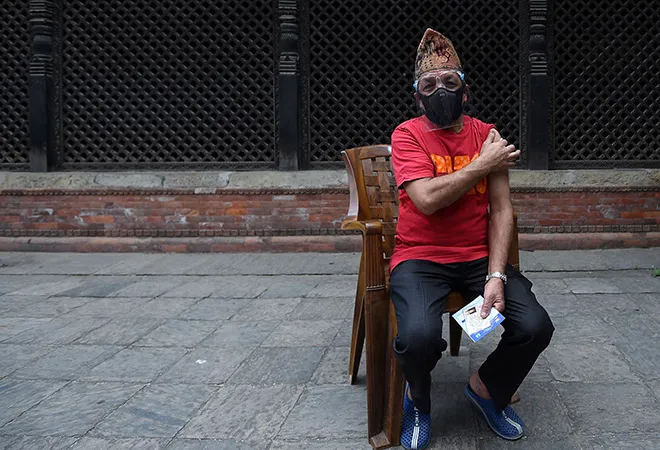
Nepal, the landlocked Himalayan nation, seems to be riding over a tempestuous tide. Striving to break free from the undulating predicament of the COVID-19 crisis, ravaging landslides, an upcoming general election, and not to mention the whirlpool of geopolitical tugs and pulls of global players. As it was trying to grapple with a COVID vaccine crisis, being confronted with the displacement of several hundreds of people has worsened the situation. As Nepal is struggling to cope, what remains to be seen is its resurgence mechanism, with an able disaster management programme and a stable healthcare system.
According to the World Health Organisation’s COVID-19 Weekly Situation Report, Number 23 (7-13 June 2021), there has been around 34.4 percent decrease in the number of new COVID cases in Nepal. Three of the most consistently affected provinces have been identified as the Bagmati province (47 percent), Province 1 (17 percent) and Gandaki province (12 percent) (See table 1). Additionally, while the national test positivity rate remains as high as 28 percent, the various provinces have cumulatively recorded 21–49 percent positivity. As of now, the main challenge is the procurement and administration of vaccines to the Nepalese population, thus, necessitating the call for international support to address this devastating scenario and help relieve some of the pressure from Nepal’s collapsing healthcare infrastructure
As of now, the main challenge is the procurement and administration of vaccines to the Nepalese population, thus, necessitating the call for international support to address this devastating scenario and help relieve some of the pressure from Nepal’s collapsing healthcare infrastructure
Table 1: District wise distribution of COVID-19 active case, as on 19 June 2021
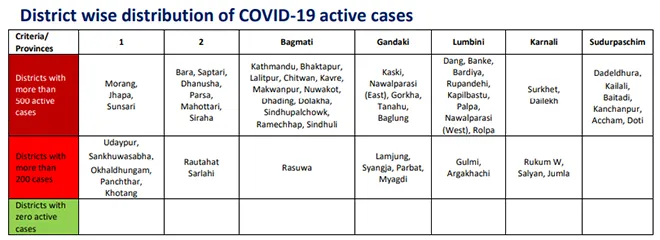 Source: Ministry of Health and Population, Government of Nepal
Source: Ministry of Health and Population, Government of Nepal
Nepal had begun its vaccination drive on January 27, by receiving 1.1 million doses of the Oxford AstraZeneca Covishield vaccine, manufactured by the Serum Institute of India, Pune, on a grant-assistance basis, as part of India’s ‘Neighbourhood First’ policy. Additionally, the country had purchased 1 million doses from the institute and received another vaccine consignment of 3.48 million doses of Covisheild by the COVAX facility with 350,000 syringes and 3,500 vaccine safety boxes in March 2021. Unfortunately, right after this phase, the unforeseen second wave of the pandemic struck with almost 32 new cases a day per 100,000 people—one of the highest in the world during that time.
India was an intrinsic part of Nepal’s vaccination campaign (through India’s ‘Vaccine Maitri’) and once the southern neighbour stopped its vaccine export due to its own surge in cases, what remained was a completely disoriented Nepal that had no other option but to appeal to every country possible, often facing disappointment. In June, only 3 million (See Graph 1) doses of the vaccine had been administered among 30 million people—with many individuals, above the age of 60, still awaiting their second dose.
India was an intrinsic part of Nepal’s vaccination campaign (through India’s ‘Vaccine Maitri’) and once the southern neighbour stopped its vaccine export due to its own surge in cases, what remained was a completely disoriented Nepal that had no other option but to appeal to every country possible, often facing disappointment
Graph 1: Total number of vaccination doses administered, as on 19 June 2021
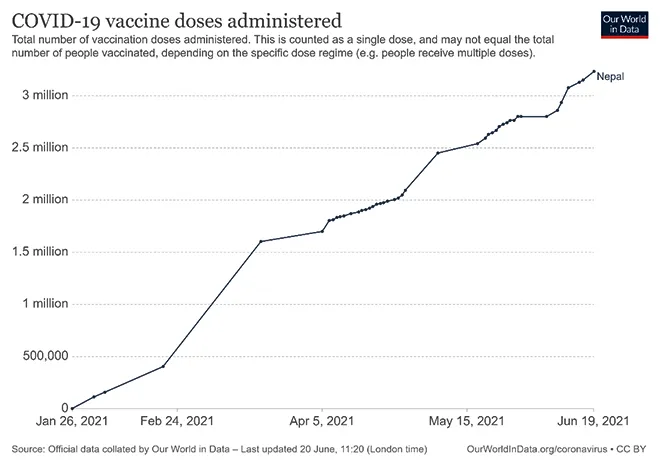 Source: Our World in Data, Country profile of Nepal
Source: Our World in Data, Country profile of Nepal
This means that only two percent of the overall population has been completely vaccinated. At the current rate, experts estimate it will take 481 days to get to 10 percent. That’s still very far away from the 60 percent–80 percent most experts believe is required for herd immunity. Around 1.4 million doses are required immediately to cover at least a few second doses that are pending.
Circumstantially, many countries have extended a helping hand, the first and foremost among them being China, granting Nepal around 0.8 million doses of the Sinopharm vaccine (Vero Cell vaccine). Apart from this, an additional 4 million vaccines have been decided to be purchased from China under a non-disclosure agreement, a step that the latter has been very stringent about. Much to the dismay of India, Nepal has been leaning towards the Chinese vaccines, creating ripples of a geopolitical turmoil in the long run in South Asian diplomacy. Many leaders in Nepal have pointed out to the anonymity vis-à-vis the pricing of Chinese vaccines (speculated by the media as US $10 per dose,) as having a strategic connotation. The Nepalese political leadership has been often believed to have delayed vaccine procurement from China as it would have supposedly antagonised India, when the latter was already sending in consignments. There was no diversification of vaccine procurement. Nepalese Prime Minister KP Oli has been blamed by the opposition party, Nepali Congress, to have been maintaining an attitude of appeasement towards the Bharatiya Janata Party (BJP) to remain in power in the upcoming general elections. Without a plan B, when India suspended vaccine supply to Nepal, there was seemingly no way out. Even now, the incognito vaccine dealing with China may be to keep the negotiation under wraps so that India is unable to gauge the exact prices that are being dealt, so as to protect any future economic correspondence that Nepal might have with India regarding vaccines. As a country sandwiched between two gigantic powers and faced with a major lag, it seems only natural for Nepal to maintain individual rapport with both of them to ensure its own safety and health security, even if that entails maintaining secrecy over its bilateral vaccine interaction.
Moreover, the United States of America has decided to provide approximately 7 million doses of vaccines to Asia, which also includes supply to Nepal after USAID declared the crisis in Nepal as the ‘highest priority’. This follows from the Xizang (Tibet) Autonomous Region granting the first batch of vaccines to Nepal, which have already reached Kathmandu. The European Union has committed to send vaccines through COVAX along with the World Health Organiation (WHO); this might take some time as it is not being conducted bilaterally. Undoubtedly, such initiatives come across as rays of hope for Nepal.
It must be noted here that many of the COVID-19 affected regions are also the provinces that have been flooded due to relentless rainfall, hence, requiring supplementary protection. Sindhupalchok in the Bagmati province remains one such place facing 400 cases of displacement, 31 deaths and several hundreds of missing people. Apart from this, two highway bridges and six motor bridges on the Melamchi Road were destroyed; Karnali, Gandaki, Lumbini, and some parts of the Bagmati province may face landslides; and Melamchi Water Supply head works and farms also faced ruination. For this, the Disaster Management Executive Committee have already begun its work and are working towards ensuring safety of the people at the earliest.
As the situation in Nepal remains harrowing and uncertain, the government and the people need to reaffirm their faith in each other. As both work hand in hand, with the support of the global forum, the country holds the potential of coming back to the forefront yet again, holding its status as one of the fastest growing small landlocked economies in the world.
As the situation in Nepal remains harrowing and uncertain, the government and the people need to reaffirm their faith in each other. As both work hand in hand, with the support of the global forum, the country holds the potential of coming back to the forefront yet again, holding its status as one of the fastest growing small landlocked economies in the world.
The views expressed above belong to the author(s). ORF research and analyses now available on Telegram! Click here to access our curated content — blogs, longforms and interviews.






 PREV
PREV

